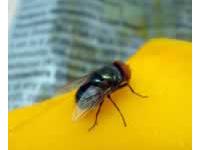Confused Flour Beetle (Also see Rust-Red Flour Beetle)
Granary Weevil (Also see Rice Weevil)
Mediterranean Flour Moth or Mill Moth
Red-legged Ham or Copra Beetle
Rice Weevil (Also see Granary Weevil)
Rust-Red Flour Beetle (Also see Confused Flour Beetle)
Tropical Warehouse or Almond Moth (Also see Warehouse, Tobacco or Cocoa Moth)
Warehouse, Tobacco or Cocoa Moth (Also see Tropical Warehouse or Almond Moth)

Appearance
Adult: Metallic blue or green thorax and abdomen; 7-9mm long, with females usually larger than males. Adults are strong fliers and make a loud, buzzing sound and are attracted to light.
Life Cycle
Eggs are laid by the female in sources of food such as dead animals or rotting meat. Larvae are whitish maggots with small black hooks to tear flesh and feed for a few days before burrowing into the soil to pupate. Adults feed on nectar. Entire life cycle from egg to adult takes between 9-21 days depending on conditions.
Notes
The name 'blow fly' comes from the fact that animal corpses swell up from bacterial decomposition in the intestinal tract, causing them to become bloated, or "fly-blown". These flies are important in nature in the decay process of animal carcasses and are usually the first insects to arrive – within hours or even minutes – after an animal dies. They are also called Blue or Green bottle flies because of their colour.

